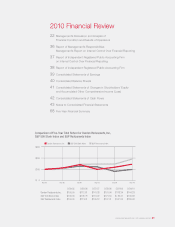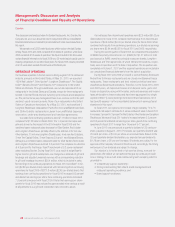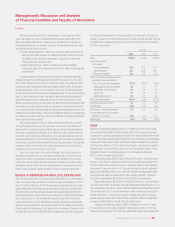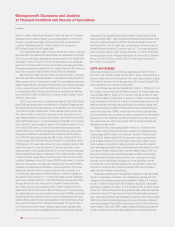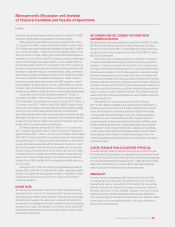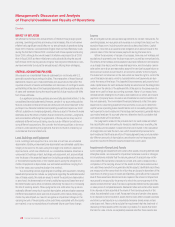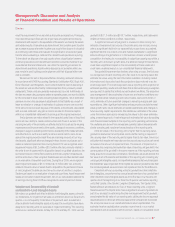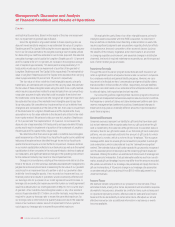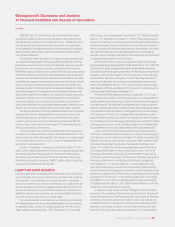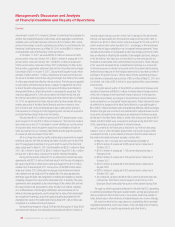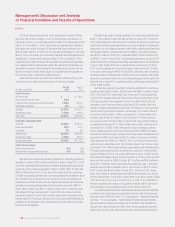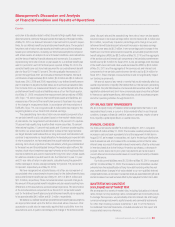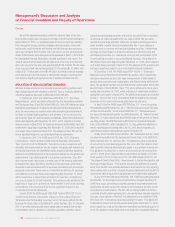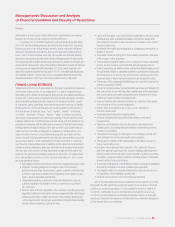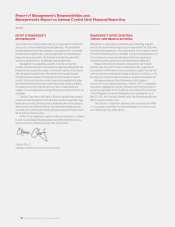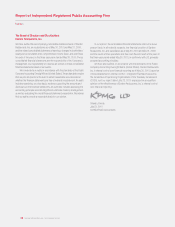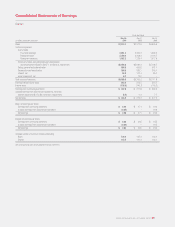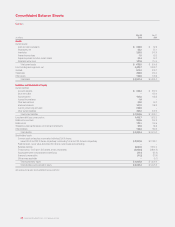Red Lobster 2010 Annual Report Download - page 32
Download and view the complete annual report
Please find page 32 of the 2010 Red Lobster annual report below. You can navigate through the pages in the report by either clicking on the pages listed below, or by using the keyword search tool below to find specific information within the annual report.
30 DARDEN RESTAURANTS, INC. | 2010 ANNUAL REPORT
Notes to Consolidated Financial Statements
Darden Restaurants
30 DARDEN RESTAURANTS, INC. | 2010 ANNUAL REPORT
Management’s Discussion and Analysis
of Financial Condition and Results of Operations
Darden
commitment. In April 2010, however, Lehman’s commitment was assigned to
another then-existing Revolving Credit Lender, so the aggregate commitments
available under our facility have been restored to $750.0 million. After consid-
eration of borrowings currently outstanding and letters of credit backed by the
Revolving Credit Agreement, as of May 30, 2010, we had $691.6 million of
credit available under the Revolving Credit Agreement.
On October 11, 2007, we issued $350.0 million of unsecured 5.625
percent senior notes due October 2012, $500.0 million of unsecured 6.200
percent senior notes due October 2017 and $300.0 million of unsecured
6.800 percent senior notes due October 2037 (collectively, the New Senior
Notes) under a registration statement filed with the Securities and Exchange
Commission (SEC) on October 9, 2007. Discount and issuance costs, which
were $4.3 million and $11.7 million, respectively, are being amortized over
the terms of the New Senior Notes using the straight-line method, the results
of which approximate the effective interest method. The interest rate payable
on each series of the New Senior Notes is subject to adjustment from time
to time if the debt rating assigned to the series of the New Senior Notes is
downgraded below a certain rating level (or subsequently upgraded). The
maximum adjustment is 2.000 percent above the initial interest rate and
the interest rate cannot be reduced below the initial interest rate. As of May
30, 2010, no adjustments to these interest rates had been made. We may
redeem any series of the New Senior Notes at any time in whole or from
time to time in part, at the principal amount plus a make-whole premium.
If we experience a change of control triggering event, we may be required to
purchase the New Senior Notes from the holders.
We also have $150.0 million of unsecured 4.875 percent senior notes
due in August 2010 and $75.0 million of unsecured 7.450 percent medium-
term notes due in April 2011 included in current liabilities as current portion
of long-term debt, which we plan to repay from a combination of cash on
hand, borrowing from our revolving credit facility and through the issuance
of unsecured debt securities in fiscal 2011.
All of our long-term debt currently outstanding is expected to be repaid
entirely at maturity with interest being paid semi-annually over the life of the
debt. The aggregate maturities of long-term debt for each of the five fiscal
years subsequent to May 30, 2010 and thereafter are $225.0 million in fiscal
2011, $0.0 million in fiscal 2012, $350.0 million in fiscal 2013, $0.0 million
in fiscal 2014, $0.0 million in fiscal 2015 and $1.06 billion thereafter.
During the first quarter of fiscal 2010, we entered into interest rate swap
agreements with $375.0 million of notional value to limit the risk of changes in
fair value of our $150.0 million senior notes due August 2010, $75.0 million
medium-term notes due April 2011, and a portion of the $350 million senior
notes due October 2012 attributable to changes in the benchmark interest
rate, between now and maturity of the related debt. The swap agreements
effectively swap the fixed rate obligations for floating rate obligations, thereby
mitigating changes in fair value of the related debt prior to maturity. The swap
agreements were designated as fair value hedges of the related debt and met
the requirements to be accounted for under the short-cut method, resulting
in no ineffectiveness in the hedging relationship. Gains and losses on the
interest rate swap agreements used to hedge the fair value of the related debt
are recognized in earnings, as are the losses and gains associated with the
changes in fair value of the related debt. During fiscal 2010, $3.4 million was
recognized as a reduction to interest expense.
During the fourth quarter of fiscal 2008 and the first quarter of fiscal 2009,
we entered into treasury-lock derivative instruments with $150.0 million of
notional value to hedge a portion of the risk of changes in the benchmark
interest rate associated with the expected issuance of long-term debt to
refinance our $150.0 million senior notes due August 2010 and our $75.0
million medium-term notes due April 2011, as changes in the benchmark
interest rate will cause variability in our forecasted interest payments. These
derivative instruments are designated as cash flow hedges and to the extent
they are effective in offsetting the variability of the hedged cash flows, changes
in the derivatives’ fair value are not included in current earnings but are
included in accumulated other comprehensive income (loss). These changes
in fair value will subsequently be reclassified into earnings as a component
of interest expense as interest is incurred on the forecasted debt issuance.
Ineffectiveness measured in the hedging relationship is recorded currently in
earnings in the period it occurs. The fair value of these outstanding treasury-
lock derivative instruments was a net loss of $10.5 million at May 30, 2010 and
is included, net of tax of $6.5 million, in accumulated other comprehensive
income (loss).
During the second quarter of fiscal 2008, we entered into treasury-lock
derivative instruments with $550.0 million of notional value to hedge a portion
of the risk of changes in the benchmark interest rate prior to the issuance
of the New Senior Notes, as changes in the benchmark interest rate would
cause variability in our forecasted interest payments. These instruments were
all settled at the issuance of the New Senior Notes for a cumulative gain of
$6.2 million. These instruments were designated as effective cash flow hedges,
therefore, the gain was recorded in accumulated other comprehensive income
(loss) and is reclassified into earnings as an adjustment to interest expense
as interest on the New Senior Notes or similar debt is incurred. Gains of $0.8
million and $0.8 million were recognized in earnings during fiscal 2010 and
2009, respectively, as an adjustment to interest expense.
We currently do not have any provisions in our interest rate swap,
treasury-lock or other derivative agreements that would require either
counterparty to hold or post collateral in the event that the market value of
the related derivative instrument exceeds a certain limit.
At May 30, 2010, our long-term debt consisted principally of:
•$350.0millionofunsecured5.625percentseniornotesduein
October2012;
•$100.0millionofunsecured7.125percentdebenturesduein
February2016;
•$500.0millionofunsecured6.200percentseniornotesduein
October2017;
•$150.0millionofunsecured6.000percentseniornotesduein
August2035;
•$300.0millionofunsecured6.800percentseniornotesduein
October2037;and
•Anunsecured,variablerate$9.8millioncommercialbankloandue
in December 2018 that is used to support a loan from us to the
Employee Stock Ownership Plan portion of the Darden Savings Plan.
Through our shelf registration statement on file with the SEC, depending
on conditions prevailing in the public capital markets, we may issue unsecured
debt securities from time to time in one or more series, which may consist of
notes, debentures or other evidences of indebtedness in one or more offerings.
We may from time to time repurchase our outstanding debt in privately
negotiated transactions. Such repurchases, if any, will depend on prevailing
market conditions, our liquidity requirements and other factors.



